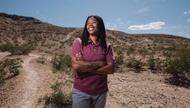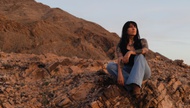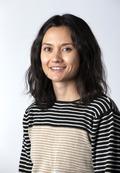Shannon Salter appears washed out in the late-morning sun as she crouches next to a yucca plant nearly twice her size and joins a Zoom call from the remote Mojave Desert. The 37-year-old poet and part-time teacher is camping out and “bearing witness” to the removal of plant and animal life to make way for a new 3,000-acre solar project.
The Yellow Pine Solar Project is being built 10 miles southeast of Pahrump and 32 miles west of Las Vegas. Salter’s camp is just outside the project’s developing footprint.
“I spent a lot of time walking on the solar site before they had the fence up. So I know what’s there … It’s interesting to look into the face of the industrial order,” Salter says, adding that there has been little public discussion about the effect this particular project will have on the desert ecosystem.
While at camp, which started with poetry readings in 2021, Salter uses her observations as a source of inspiration for poetry. For her online tutoring job, she charges electronics with a 100-watt solar panel. As an activist, Salter has been monitoring applications for renewable energy projects in Pahrump Valley west of Las Vegas, attending public meetings to give input and speaking with locals in Tecopa, Shoshone and Pahrump.
Salter posts updates to the Twitter account of her organization Mojave Green (@MojaveGreen8) , and has started a Change.org petition asking the Secretary of the Department of the Interior and President Joe Biden to stop subsidizing solar projects that disrupt desert life, and instead start subsidizing solar projects in urban areas. At the end of May, Secretary Deb Haaland visited Nevada to announce that the federal government will reduce rents and fees for solar and wind projects on public lands, to help reach the goal of 25,000 megawatts of renewable energy on public land by 2025.
“I’m totally in favor of solar—on people’s rooftops and over parking lots,” Salter says. “Preserving wild land is just as important as making solar [energy]. We just don’t want to put it in a place that’s going to destroy a whole ecosystem.”
She says the Yellow Pine Solar Project is “just the beginning,” with five other projects slated for the area.
Why are you doing this?
I want to bear witness to something that is not very carefully looked at. There’s often this impression that the desert is this empty space. And it is full of a great distance, which is part of what makes it so magical and so powerful. But it’s also certainly not empty. There’s an entire ecosystem of ancient thousand-year old plants and desert crusts and bacteria and all kinds of things here, and animals, of course.
How did your activism start?
In 2017, there was a wind turbine proposal in my favorite area of Earth, which is the Wee Thump Joshua Tree forest, outside of Searchlight, Nevada. And it’s a now really infamous proposal.
I was just shocked that there would be that kind of proposal in that area. And so I said, “No way … We can’t live like this.” I can’t live like this—I need this Joshua tree forest for my health, for my mental health. That’s where I go to have solitude and have prayer to feel close to the universe and close to God.
So I went to every Bureau of Land Management meeting … I went door to door in Sen. Jacky Rosen’s district, because her office seemed somewhat concerned about it. I got to know the developers, too … Luckily, everyone came out against that project.
How do your practices of immersing yourself in the landscape and “bearing witness” inform your art?
I spent 10 years in Las Vegas, and I love Las Vegas with all my heart. But I can’t imagine living there now. When we live in the suburban world, we’re really living in the industrial order. We’re driving our cars to the strip malls and going to the grocery store where everything is brought in on trucks. And the kids are going to school and learning from textbooks that are all produced by the industrial order. So we’re living amidst this kind of terror, and not really even paying attention to it—because, it’s just the life.
I think poetry in particular, for me, is really connected to what I can see. It’s connected to the visible world, you know, I write what I can see. The more you see, the more there is to see … the closer you look at something, the more you know.
Click HERE to subscribe for free to the Weekly Fix, the digital edition of Las Vegas Weekly! Stay up to date with the latest on Las Vegas concerts, shows, restaurants, bars and more, sent directly to your inbox!




